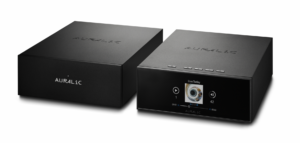
Turntable of the Year
Origin Live Sovereign

The Origin Live Sovereign is a belt-driven turntable design featuring a high tolerance bearing, and a non-suspended chassis sitting on three adjustable towers. The platter is a composite of a machined aluminium top with an acrylic lower section and a felt mat, designed to decouple the record surface and is driven by a high-mass outboard motor.
We used the Sovereign with the excellent 12” Enterprise-C tonearm, a hybrid design with six different materials in the armtube and a dual pivot bearing that mimics the stability of a gimballed bearing with the freedom of a unipivot. In our review, Alan Sircom stated that “There is a ‘just cut’ fluidity and openness to the sound that makes it seem like albums you know through repeated plays are fresh from the stamper” and concluded that “It’s one of those rare turntables that doubles as a time machine; you don’t just play an album, you are transported to where you were when you first heard that album.”
Reviewed in Hi-Fi+ Issue 140
Tonearm of the Year
Kuzma 4POINT 14

The original 11” 4POINT is considered to be one of the best high-performance tonearms made today, but in extending the original arm-tube to 14”, Kuzma faced potential mass and stability problems. The increased arm size means an effective mass of 19g, which makes it best used with low compliance cartridges, and its 2.15kg weight precludes its use with most suspended turntable designs, but the mounting geometry makes Kuzma’s super arm compatible with 12” armboards and allows an almost infinite amount of on-the-fly adjustment. In our review Roy Gregory felt that “this is one seriously impressive performer. Put a 4POINT 14 in your system and sit back as your speakers apparently expand in size (at the same time as they disappear), your cartridge grows in power, and the musicians on your records don’t just wake up, they decide that today is the day.” High praise indeed!
Reviewed in Hi-Fi+ Issue 133
Cartridge of the Year
DS Audio DS-W1
Undoubtedly the most exciting development in phono cartridge design since the invention of the moving coil, Japanese audiophile brand DS Audio’s unique DS-W1 consists of an optical cartridge and matching equaliser. Although it uses a conventional stylus and cantilever, the cartridge itself uses a tiny plate and slot arrangement to allow a photoelectric cell to measure the amount of movement in the groove, in place of coils and magnets. While the DS Audio cartridge is exacting to set-up and match to an arm, Roy Gregory felt it was worth the effort, saying “Never have I heard a cartridge that can capture instrumental textures or vocal nuance, the skin of a drum and the air inside it, or the rasp of bow on strings as naturally and effortlessly as this.”
Reviewed in Hi-Fi+ Issue 136
Phono Stage of the Year
Audio Research Reference Phono 3

Audio Research has long been a fixture in the high-performance phono stage sweepstakes, but even in reflection of the firm’s 46-year run at the top of the of the phono stage game, the performance of the Reference Phono 3 took us by surprise. Perhaps it really shouldn’t have; Audio Research has been on a roll for the last few years, and product after product has come out that shifts the goal posts to show what records are capable of, plus the existing Reference Phono 2SE was a big hitter. Just how much can this new model improve upon what went before?
It turns out, there was a significant chunk of ‘better’ to be had. If anything, the Reference Phono 3 owes more to the two box, cost-no-object Reference Phono 10 equaliser, and the Reference Phono 3 features six 6H30 valves in the analogue stage, plus a further 6550 in the power supply. It retains the clever Audio Research hybrid circuit, using input FETs to maintain authority over the cartridge itself, while the valves in the analogue stage maintain linearity and a sense of warmth and air in the mid and top. In test, Alan Sircom praised the phono stage for a sound that, “combines the texture, soundstage spaciousness, and richness of valve phono stages with the detail and silent backgrounds of solid state. This is a balance, but it’s both a dynamic one, and one that will appeal to many, many listeners. This sense of balance makes for a presentation that is extremely realistic, irrespective of the music played.”
Reviewed in Hi-Fi+ Issue 136















